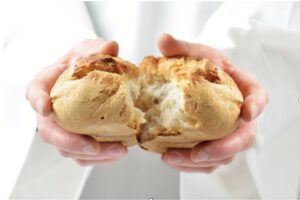From birth to Magna Graecia

In fact, in this story, the Egyptian people wrote a crucial chapter, called “The Great People”, which according to the historian Herodotus (484 – 425 B.C.) “did everything differently than ordinary humans.” Excellent farmers, they were the first true bakers and laid the foundations for bread to be infinitely successful and without limits.
Basically, at a time when the Romans were still fed “porridge of flour” and the Greeks from a kind of pastry cooked over a fire, the Egyptians already systematically applied what would later be called “natural yeast”.
All this was then considered a mysterious phenomenon, possibly of supernatural origin. How did the Egyptians do such a miracle?
They discovered that to obtain the “magical” result, it was enough to add a piece of pasta left over from the previous day to the mixture of ground grains and water, with a slightly pungent taste, and for this reason he was jealously warned, as if it were something sacred in every Egyptian house.
The experimental observation was somewhat accidental, but by resorting to this little trick, the Egyptians became the undisputed masters of the art of baking and earned the nickname “bread eaters”.
Later, the secrets of Egyptian bread were revealed and somehow learned by the Jews who, despite the great teachings, were only producing a kind of round cake three centimeters thick. Among the people of Israel, who attributed very important religious meanings to bread, the baker’s profession enjoyed great prestige and each city had a public oven used for baking dough.
The Greeks also learned to make bread from the Egyptians, for whom the idea of bread in their world was closely connected with the idea of the fertility of the earth (just think of Demeterthe goddess depicted with the harvest, is celebrated during the Eleusinian mysteries rites associated with agricultural cults).
As in all great civilizations, the symbolic meaning of bread was also closely related to Rome. Although icons are scarce in this respect, there is no shortage of interesting examples, such as large loaves with a dark crust wrinkled by a large cross depicted in a stone sarcophagus after the conquest of Greece.
From ancient Rome to the eighteenth century
However, in Rome, bread came into daily use only at the end of the republican period: according to Pliny, bread was introduced in 168 BC. AD, by some slaves who were captured in Macedonia after the defeat of King Perseus.
In the “eternal city”, where the first shops selling bread were built, the class of millers appeared first, and then the class of bakers: during the reign of Trajan (emperor from 98 to 117 AD), these “gentlemen” were united in companies and began to deliver bread to the whole community.
In the time of the Roman Empire, bread was the staple food of a large part of the population and it had to be guaranteed to all and for this reason there was specific legislation in effect.
But what kinds of bread were made in mighty ancient Rome and how many? Pliny, for example, tells of Panis Streptipcius (one of the ancestors of today’s pizza, consisting of a light dough of flour, water, milk, oil, lard, and pepper, quickly cooked in thin sheets), of Artologalum (a type of dough used as an appetizer), Panis Adipatus ( seasoned with chunks of lard and bacon), and Panis Testicius (ancestor of Romania Piada, prepared and consumed by legionaries in their camps).
In the second century BC references to the art of baking were found and with Vitruvius there the “hand-operated stone mill” was replaced by the water mill. But with Emperor Augustus, bread became a real public service. After a short period of decline, due to the collapse of the Holy Roman Empire and the emergence of barbarian civilizations, the consumption of bread did not stop thanks to the monasteries and feudal civilization, and precisely in the Middle Ages, thanks to the latter, the first guilds of bakers and millers began to form.
The preparation of bread has hitherto become a ritual, with its methods and properties: throughout Italy, and especially in Altamura, the tradition was that the mass be tied by housewives who almost once prepared this product. In the week.
This custom, which persisted until the threshold of the Second World War, is connected with a ban on the citizens of each country to cook dough in their homes, under pain of paying a fine. The local authorities wanted to control the consumption of such an important raw material as durum wheat, which was subject to a quota system (all this was confirmed in the municipal laws of the city of Altamura in 1527, which speak of “furnace duty”). And so, in the evening, the housewife prepares a loaf of bread and wraps it in a cloth to rise in the “cupboard”. The next dawn, in the streets, the baker’s voice was heard announcing the withdrawal of the lump of pastry, and then he went to the oven to cook it, for a small sum of money. The baker proceeded with casting and with the brand made of wood or wrought iron he brought back the initials of the paterfamilias, ensuring the association between each form of baked bread and the original families.
Moreover, in seventeenth-century Italy, misery abounded: in addition to the meticulous rationing of every loaf, there were an infinite number of taxes levied on every modest piece of bread, the most undesirable ever invented: from the ‘gabelle’ for flour, to the “duty” of cooking in ovens owned by the owner (and no longer public).
From the nineteenth century to the present day
In the nineteenth century, things began to change: in this century, in fact, the foundations were laid for the current method of production and conception of bread as a basic food that must be guaranteed to all.
The industrial revolution of the nineteenth century completely changed the mechanisms of production even for bread: until then, productivity was in fact limited because it was only produced and marketed locally.
With the industrial revolution everything is different. Bread is also produced on a large scale, using modern kneading machines and ovens for better and faster cooking.
However, bread consumption in Italy is slowly declining. By analyzing the following graph, we can clearly see a drop of almost 1,000% in the consumption of bread in Italy: an incredible number, especially if we are aware of the fact that all this happened over a period of more or less than a century.

However, the technological innovations of the Industrial Revolution have resulted in the production of white flour that is increasingly refined and increasingly free from those ingredients found in the outer parts of the grain, and thus a significant loss of nutrients, such as vitamins and minerals, occurs.
From a quantitative and nutritional point of view, the largest and most significant loss of . occurs fiber Which we will discuss in Part Two.
for further information:
https://www.facebook.com/BONUMVITANUTRIZIONE
Dr. Emmanuel Vanilla, Dietitian Biological – Dr. Berlini Diego, Food Technologist

“Infuriatingly humble social media buff. Twitter advocate. Writer. Internet nerd.”











